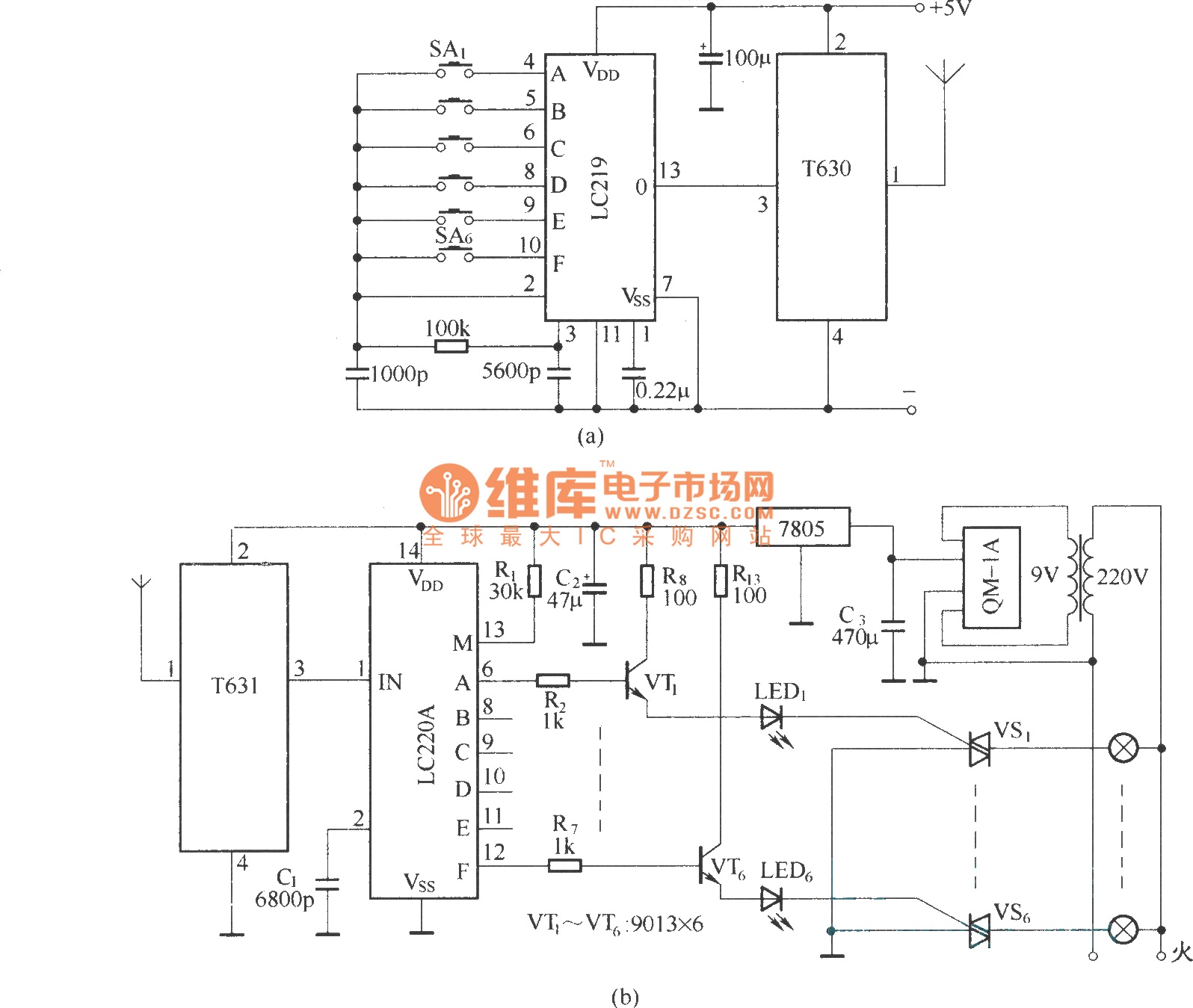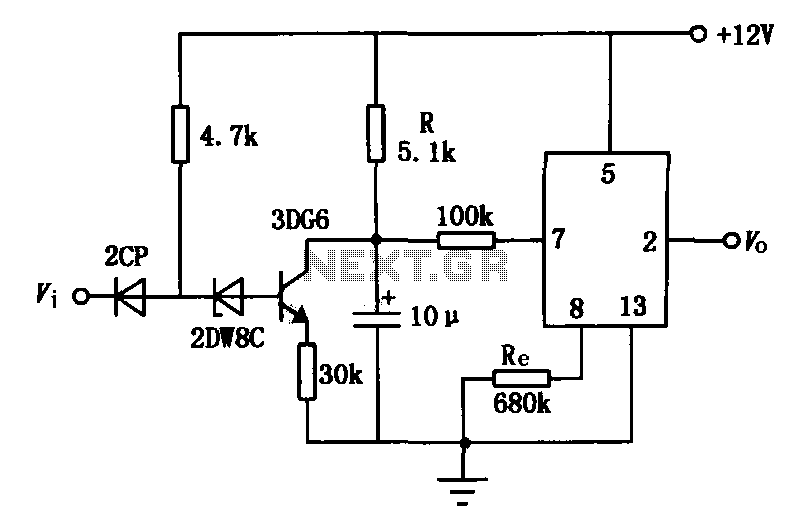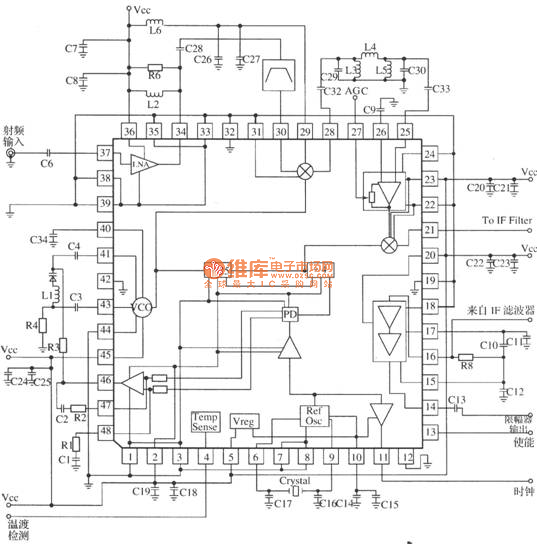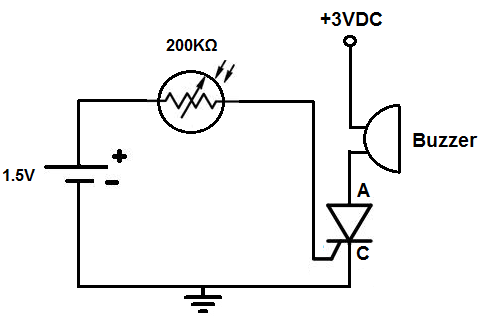
Battery-Operated Black Light Circuit
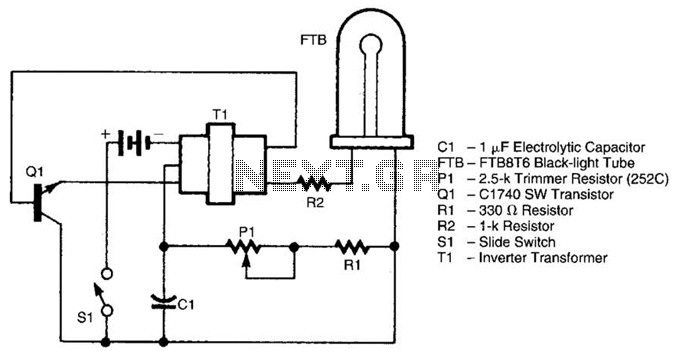
The battery-operated black light utilizes a U-shaped, unfiltered black-light tube, which requires approximately 250 Vac for operation. To generate the 250 Vac from a 6-V battery, the circuit employs a one-transistor blocking oscillator that drives a ferrite inverter transformer. A blocking oscillator ceases operation after one or more cycles. In this circuit, it includes components CI, PI, Q1, R1, and T1. The oscillations are maintained because the base of Q1 is connected to one of the windings on T1. Transformer T1 is a step-up transformer featuring a ferrite core, with a few turns on the primary and many turns on the secondary. The oscillating AC output from Q1 is directed to T1, which, due to its significant turns ratio, converts the low-voltage signal into a high-voltage alternating current. This high-voltage AC is then coupled through resistor R2 to the black-light tube. Resistor R1 and the trimmer resistor PI limit the current flowing through the circuit. Adjusting PI allows for an increase in current flow, resulting in a brighter light output.
The described circuit functions as a compact and efficient means to produce high-voltage AC from a low-voltage DC source, specifically a 6-V battery. The blocking oscillator configuration is crucial for generating the necessary oscillations that drive the transformer. Component Q1, typically a transistor, acts as the primary switch, rapidly turning on and off to create the desired frequency of oscillation. The feedback mechanism, where the base of Q1 is connected to the transformer winding, ensures that oscillations are self-sustaining, allowing for continuous operation until the battery is depleted.
Transformer T1 plays a pivotal role in stepping up the voltage. Its design, characterized by a ferrite core, is optimized for high-frequency operation, which is essential for efficient energy transfer at the levels required for the black-light tube. The turns ratio of T1 is designed to maximize voltage conversion while minimizing losses. The output from T1 is an alternating current that is suitable for the black-light tube, which requires a specific voltage and current to emit ultraviolet light effectively.
Resistor R1 serves as a current limiter to protect the circuit components from excessive current that could lead to damage. The inclusion of trimmer resistor PI allows for fine-tuning of the circuit's brightness by adjusting the current flow, providing versatility in light output based on user preference. Resistor R2 further ensures that the current delivered to the black-light tube is within safe operational limits, contributing to the overall stability and reliability of the circuit.
In summary, the circuit design for the battery-operated black light is a well-engineered solution for generating high-voltage AC from a low-voltage DC source, utilizing a blocking oscillator and a ferrite transformer to achieve the desired performance while maintaining safety and efficiency. The battery-operated black light uses a U-shaped, unfiltered, black-light tube, which requires approximately 250 Vac to operate. To create the 250-Vac 6-V battery, the circuit uses a one-transis-tor blocking oscillator that drives a ferrite inverter transformer.
A blocking oscillator turns itself off after one or more cycles. In this circuit, it consists of CI, PI, Ql, Rl, and Tl. The oscillations are sustained because the base of Ql is connected to one of the windings on Tl. Transformer Tl is a step-up transformer that consists of a ferrite core, which has a few turns on the primary and many turns on the secondary. The oscillating (ac) output of Ql is fed to Tl, which, because of its large turns ratio, converts the low-voltage signal into a high-voltage alternating current, which is coupled through resistor R2 to the black- light tube. Resistor Rl and trimmer resistor PI limit the current flowing through the circuit. As the control on PI is rotated, more current flows in the circuit, producing a brighter light output.
The described circuit functions as a compact and efficient means to produce high-voltage AC from a low-voltage DC source, specifically a 6-V battery. The blocking oscillator configuration is crucial for generating the necessary oscillations that drive the transformer. Component Q1, typically a transistor, acts as the primary switch, rapidly turning on and off to create the desired frequency of oscillation. The feedback mechanism, where the base of Q1 is connected to the transformer winding, ensures that oscillations are self-sustaining, allowing for continuous operation until the battery is depleted.
Transformer T1 plays a pivotal role in stepping up the voltage. Its design, characterized by a ferrite core, is optimized for high-frequency operation, which is essential for efficient energy transfer at the levels required for the black-light tube. The turns ratio of T1 is designed to maximize voltage conversion while minimizing losses. The output from T1 is an alternating current that is suitable for the black-light tube, which requires a specific voltage and current to emit ultraviolet light effectively.
Resistor R1 serves as a current limiter to protect the circuit components from excessive current that could lead to damage. The inclusion of trimmer resistor PI allows for fine-tuning of the circuit's brightness by adjusting the current flow, providing versatility in light output based on user preference. Resistor R2 further ensures that the current delivered to the black-light tube is within safe operational limits, contributing to the overall stability and reliability of the circuit.
In summary, the circuit design for the battery-operated black light is a well-engineered solution for generating high-voltage AC from a low-voltage DC source, utilizing a blocking oscillator and a ferrite transformer to achieve the desired performance while maintaining safety and efficiency. The battery-operated black light uses a U-shaped, unfiltered, black-light tube, which requires approximately 250 Vac to operate. To create the 250-Vac 6-V battery, the circuit uses a one-transis-tor blocking oscillator that drives a ferrite inverter transformer.
A blocking oscillator turns itself off after one or more cycles. In this circuit, it consists of CI, PI, Ql, Rl, and Tl. The oscillations are sustained because the base of Ql is connected to one of the windings on Tl. Transformer Tl is a step-up transformer that consists of a ferrite core, which has a few turns on the primary and many turns on the secondary. The oscillating (ac) output of Ql is fed to Tl, which, because of its large turns ratio, converts the low-voltage signal into a high-voltage alternating current, which is coupled through resistor R2 to the black- light tube. Resistor Rl and trimmer resistor PI limit the current flowing through the circuit. As the control on PI is rotated, more current flows in the circuit, producing a brighter light output.

